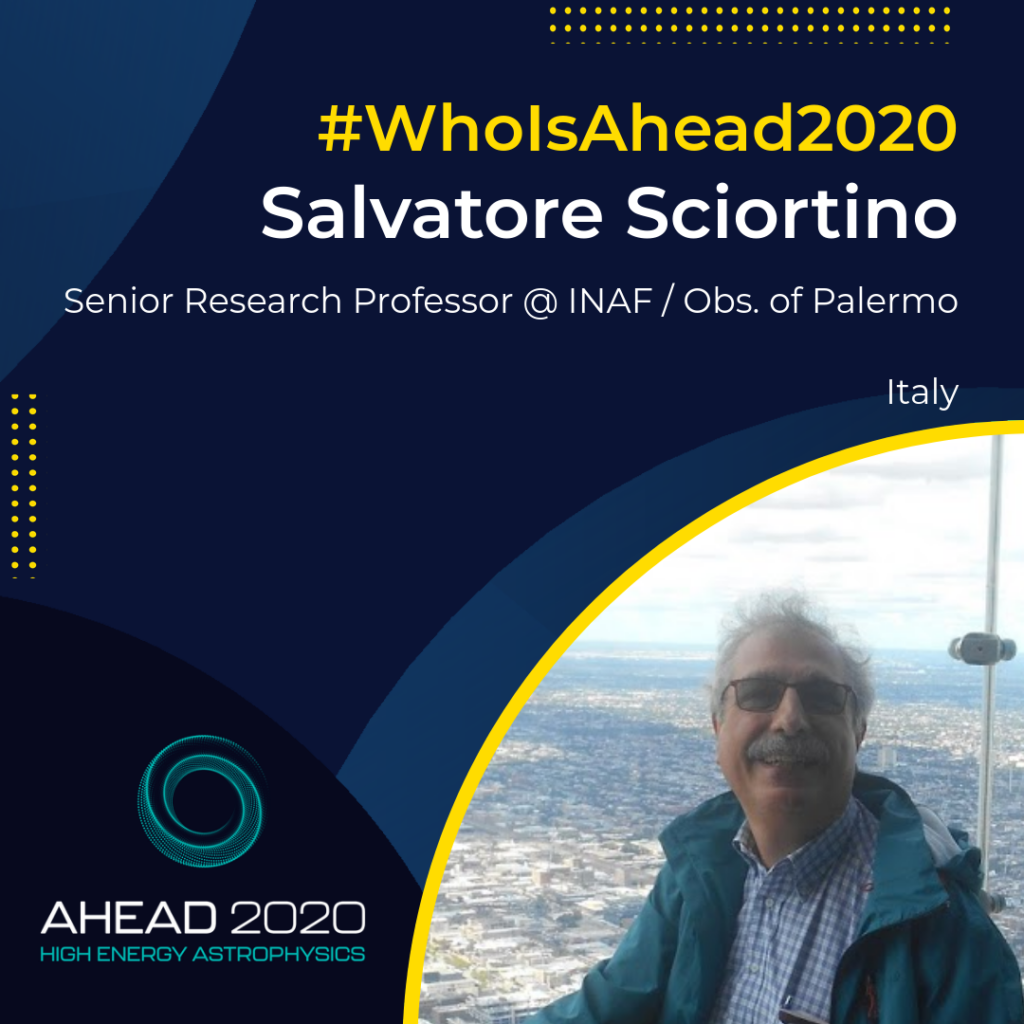![]() Prof. Salvatore Sciortino is an Astronomo Ordinario (Senior Research Professor) working from more than 40 years in the field of Astronomy, specifically of X-ray #Astronomy. During his career, he has conceived, pursued and directed many research activities, programs and projects. He is the coordinator of the #AHEAD2020 work package for the experimental facilities TNA, a member of the Management Team and involved in the Data Analysis TNA activity to be performed at the INAF/OAPA. His current research activity focus on multi-wavelength studies of young #stars and #protostars in star forming regions.
Prof. Salvatore Sciortino is an Astronomo Ordinario (Senior Research Professor) working from more than 40 years in the field of Astronomy, specifically of X-ray #Astronomy. During his career, he has conceived, pursued and directed many research activities, programs and projects. He is the coordinator of the #AHEAD2020 work package for the experimental facilities TNA, a member of the Management Team and involved in the Data Analysis TNA activity to be performed at the INAF/OAPA. His current research activity focus on multi-wavelength studies of young #stars and #protostars in star forming regions.

How do you describe your journey in astronomy so far![]()
![]() My research thesis dates back to 1978, during the 4 decades since then I have been impressed and delighted by the tremendous increase of our ability to study the celestial bodies across the entire Universe. The space-borne observatories and many new technologies have made possible to observe at all wavelengths. It is perhaps emblematic that my thesis was based on Far-IR observations from a balloon-borne telescope and then I moved into the field of imaging X-ray observations opened up in 1978 by the Einstein observatory led by the late Nobel Laureate Prof. Riccardo #Giacconi. The last 20 years have been marked by Chandra X-ray Observatory, and XMM-Newton Satellite and Athena X-ray observatory will mark the next decade.
My research thesis dates back to 1978, during the 4 decades since then I have been impressed and delighted by the tremendous increase of our ability to study the celestial bodies across the entire Universe. The space-borne observatories and many new technologies have made possible to observe at all wavelengths. It is perhaps emblematic that my thesis was based on Far-IR observations from a balloon-borne telescope and then I moved into the field of imaging X-ray observations opened up in 1978 by the Einstein observatory led by the late Nobel Laureate Prof. Riccardo #Giacconi. The last 20 years have been marked by Chandra X-ray Observatory, and XMM-Newton Satellite and Athena X-ray observatory will mark the next decade.
Why did you choose to study astrophysics![]()
![]() When I was young I was deeply interested in science and more specifically in #Physics. I decided to study Physics and, at the time to choose my thesis, I was attracted by astrophysics, which in those days was entering in a golden age of many intriguing discoveries.
When I was young I was deeply interested in science and more specifically in #Physics. I decided to study Physics and, at the time to choose my thesis, I was attracted by astrophysics, which in those days was entering in a golden age of many intriguing discoveries.
Do you have a favorite scientific theory![]()
![]() Astronomy is driven by observations and I like the many unexpected discoveries that spur when we improve the instrumentation capabilities. A couple of examples, related to my research field, are the spectacular images of circumstellar disks obtained with the #HST, and the discovery, enabled by the #Einstein observations, of the 3-4 decades decrease of X-ray emission of stars with increasing stellar age, a fact with a major impact on the early evolution of circumstellar disks and planetary systems.
Astronomy is driven by observations and I like the many unexpected discoveries that spur when we improve the instrumentation capabilities. A couple of examples, related to my research field, are the spectacular images of circumstellar disks obtained with the #HST, and the discovery, enabled by the #Einstein observations, of the 3-4 decades decrease of X-ray emission of stars with increasing stellar age, a fact with a major impact on the early evolution of circumstellar disks and planetary systems.
Why is #AHEAD2020 important to you![]()
![]() AHEAD2020 is one of the best opportunity to build a strong European community in the field of High Energy and Multi-messenger Astrophysics. It enables several multi-facets activities including technological developments, exchange of experiences, organization of meetings and research visits. Being part of #AHEAD2020 offers the opportunity to contribute to and maintain a state of the art knowledge of this research field.
AHEAD2020 is one of the best opportunity to build a strong European community in the field of High Energy and Multi-messenger Astrophysics. It enables several multi-facets activities including technological developments, exchange of experiences, organization of meetings and research visits. Being part of #AHEAD2020 offers the opportunity to contribute to and maintain a state of the art knowledge of this research field.
What is the best word describing #astronomy![]()
![]() Fascinating
Fascinating
